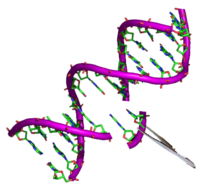
Photo from wikipedia
Selfish genetic interactions in nematodes Identifying the effects and evolution of selfish genetic elements can be difficult because of their biased inheritance. Ben-David et al. identified a selfish genetic element… Click to show full abstract
Selfish genetic interactions in nematodes Identifying the effects and evolution of selfish genetic elements can be difficult because of their biased inheritance. Ben-David et al. identified a selfish genetic element that drives maternal-effect lethality in the nematode Caenorhabditis elegans (see the Perspective by Phadnis). This incompatibility stems from the interaction between a maternally deposited toxin and a zygotically expressed antidote. Interestingly, the antidote is encoded by the gene pha-1, which has been described as an essential gene in embryonic development. Science, this issue p. 1051; see also p. 1013 A gene thought to be essential for nematode worm development is, in fact, a toxin antidote and part of a selfish genetic element. Selfish genetic elements spread in natural populations and have an important role in genome evolution. We discovered a selfish element causing embryonic lethality in crosses between wild strains of the nematode Caenorhabditis elegans. The element is made up of sup-35, a maternal-effect toxin that kills developing embryos, and pha-1, its zygotically expressed antidote. pha-1 has long been considered essential for pharynx development on the basis of its mutant phenotype, but this phenotype arises from a loss of suppression of sup-35 toxicity. Inactive copies of the sup-35/pha-1 element show high sequence divergence from active copies, and phylogenetic reconstruction suggests that they represent ancestral stages in the evolution of the element. Our results suggest that other essential genes identified by genetic screens may turn out to be components of selfish elements.
Journal Title: Science
Year Published: 2017
Link to full text (if available)
Share on Social Media: Sign Up to like & get
recommendations!